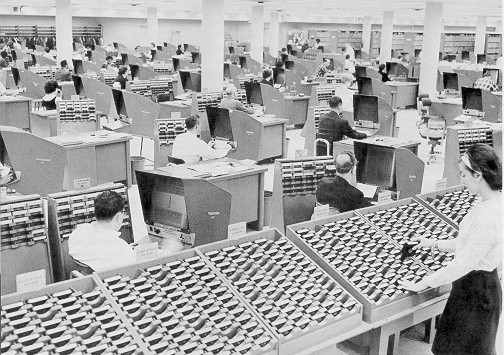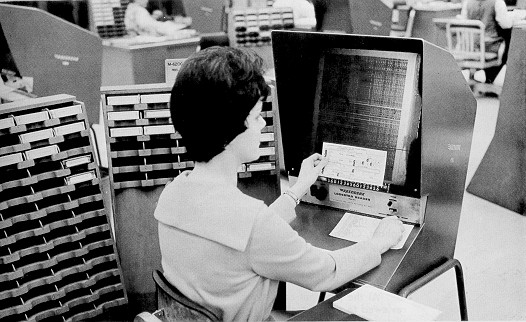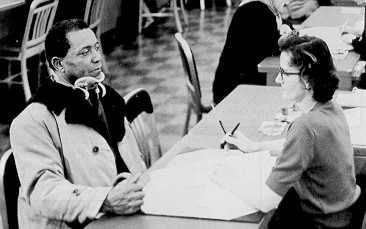|

 |
|
FROM ACCOUNT NUMBER
TO BENEFIT--HOW WE OPERATE |
AMONG the archeological finds of recent years
was a cache of clay tablets--the complete operating records of a
shipping company that went out of business at least 2000 years ago.
Two thousand years from now, the stainless
steel capsule sealed within the cornerstone of the Social Security
Building in 1959 may be unearthed with its record of how the social
security program operated in 1959. But that description of operations,
prepared just a few years ago, is already out of date.
In the centuries between the clay tablets
of the ancient shipping company and today, there have been several
revolutions in the methods of performing office or clerical operations.
And today, we are in the midst of an office revolution that may
make the typewriters and business machines of the first half of
the 20th century seem equally antique.
The task of social security recordkeeping
began as a big operation--one that many skeptics said was an impossible
undertaking. Preliminary estimates were that 26 million individual
social security accounts would have to be set up before the end
of 1937--the first year of the program's operation. Actually, over
33 million accounts were established during that period. By the
end of 1963, the number of accounts had grown to over 150 million,
of which about 75 million are active in any one year.
To handle this mass of records quickly, efficiently,
and economically, right from the beginning extensive use was made
of punched card and micro-film equipment and of modern business
machines. In fact, some business machines now in common use were
practically born on social security premises.
In the years since, the working population
has increased, the coverage of the program has been extended to
many more occupations, and the number of persons receiving monthly
benefit payments has grown astronomically--from 250,000 in 1940,
the year when benefits first became payable, to 20,000,000 in 1964.
With these increases in workloads has come
a need for greater speed and accuracy and for the delegation of
more of the routine jobs from men and women to machines. Fortunately,
as the recordkeeping and benefit payment operations increased in
size and complexity, new electronic equipment capable of handling
more complex clerical routines graduated from the drawing board.
|

|
|

|
National Employee Index
The National Employee Index, arranged according to an alphabetic
soundex code, is used as a cross reference to social security
earnings records which are set up in order of social security
account number. The Index is referred to, for example, when
a worker who has lost his card applies for a duplicate. (About
3.9 million duplicate cards are issued each year.)
The National Employee Index now contains 200 million names
for the more than 150 million people to whom social security
account numbers have been issued since 1936. (70 percent of
the women are listed under both their married and maiden names.) |
|

|
Until 1958, the names
were typed on flexible strips inserted in metal panels and
hung on racks like pages in a book. With 119 names to a panel
and 1,600 panels to a rack, the mammoth file took up a city
block of floor space. It was growing at the rate of about
3 million names a year and required 6,000 additional square
feet of space every 12 months.
In 1958 the Index was microfilmed. Since then, all new names
are listed on magnetic tape and then converted to microfilm
by means of the Special Microfilm Printer. The Special Microfilm
Printer transcribes coded data directly from magnetic tape
into a readable microfilm record.
The 200 million names in the National Employee Index are contained
on 2005 reels of magnetic tape. These reels, divided among
about 90 "stations," are referred to by means of
high-speed microfilm readers. |
In 1956, the Social Security Administration
installed the first large-scale computer to maintain records of
earnings and to compute the benefits payable to workers and their
families when they retire, become disabled, or die. Electronic data
processing equipment has also been used for several years in the
benefit payment operations and in the maintenance of the beneficiary
rolls.
An integrated data processing system is now
being developed to link the earnings record operations with the
benefit-paying operations. When this integrated data processing
system is put into full effect sometime in 1965, it will cover the
entire range of operations, from the initial establishment of a
social security account, through maintenance of a lifetime earnings
record, to the initial adjudication of a claim, the payment of benefits
and subsequent changes in the benefit rolls. The fully integrated
data processing system of the future will enable the Social Security
Administration to handle a greatly increased volume of work, to
gather more quickly the information needed for claims decisions,
and to solve the problems of distance inherent in a decentralized
organization with nationwide responsibilities.
|

|
The seven payment centers, located
in key cities in the U.S., act as reviewing offices and make
the formal determinations as to entitlement to benefits. They
also keep the benefit rolls up to date and accurate.
Old-age and survivors insurance claims and beneficiaries are
divided among the six payment centers located in New York,
Philadelphia, Birmingham, Chicago, Kansas City, and San Francisco.
The seventh payment center, located at the Social Security
Building in Baltimore, handles all disability claims and maintains
the roll of disability beneficiaries. The Baltimore payment
center also keeps the roll of beneficiaries who live abroad.
At the payment center, claims forwarded by the district offices
are reviewed to see that all necessary applications have been
properly completed; that all the evidence needed for the claim
has been obtained; that all requirements set by law have been
met; and that all benefit amounts have been figured correctly.
If the claimant is found to be entitled to benefits, the claim
is approved and the Treasury Department is notified that payment
should be made.
The payment centers authorize the Treasury Department to issue
the beneficiary's first benefit check and every succeeding
monthly benefit check he will receive. During 1964 the payment
of an average of 20 million benefit payments will be certified
each month and about 880,000 changes will be made in the roll
of benefits each month as new beneficiaries are added and
as others change their addresses, have their benefits suspended
because of earnings, or must be taken off the rolls because
of death, remarriage, or other reasons. |
|

|
The Social Security Administration
has 613 district offices located throughout
the 50 States, the District of Columbia, and Puerto Rico.
These offices have representatives who visit outlying areas
to serve people who live at a distance from the city or town
in which the district office is located. These regularly scheduled
visits are made to some 3,000 locations called contact stations.
If necessary, a field representative will go to the home of
anyone who is unable to visit the social security office because
of illness or infirmity.
It is here at the district office level that the full cycle
of services originates . . . from account number to benefit.
The district office is the place where a person gets his social
security account number, where he can check on his earnings
record, where he can get full information about his and his
family's rights under the social security law, and where,
eventually, he or his family will file a claim for old-age,
survivors, or disability insurance benefits.
Each district office also carries on an extensive information
program aimed at a better public understanding of old-age,
survivors, and disability insurance. Booklets, posters, speeches
before groups and organizations, newspaper and magazine articles,
special exhibits, radio and television programs--these are
some of the media used to tell people what they need to know
about social security. |
|

|
Because entitlement to disability
benefits (or to childhood disability benefits) involves a
determination of disability, there are important additional
steps in the processing of a disability claim.
The social security district office gives the disabled applicant
information about his rights, helps him to file his application
and to get proofs and documents he may need to support that
application. The disabled person is required to obtain the
medical evidence needed to show the extent of his disability.
This medical evidence can be supplied either by his attending
physician or by a hospital, institution, public or private
agency where he has been treated for his disabling condition.
The social security district office does not, however, evaluate
his disability.
After the disabled person has made his application for benefits
and supplied the supporting evidence, the folder on his case
is transferred to the agency of his State designated in the
agreement between the State and the Federal Government. In
most States the designated agency is the State vocational
rehabilitation agency.
Determinations of disability are made by "review teams"
in the State agencies. There are at least two professional
people on each team. One is a doctor of medicine; the other
is a person trained in evaluating the personal and vocational
aspects of disability such as age, education, and work experience.
The physician member of the State agency evaluation team is
often a practicing physician who serves with the State agency
on a part-time basis. In the larger State agencies, the reviewing
physicians may be under the supervision of a medical consultant. |
 |
|